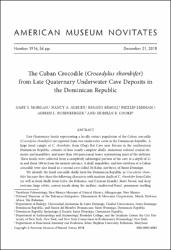/admin/item?itemID=d1032a50-7eec-4ea6-a667-e67d1fe65369
The Cuban crocodile (Crocodylus rhombifer) from late Quaternary underwater cave deposits in the Dominican Republic

View/
Type of Access
OpenMaterial Type
ArticleType of Content
Scientific researchLanguage
EnglishCollection
- Investigación ambiental [1761]
Metadata
Show full item record| Abstract: | Late Quaternary fossils representing a locally extinct population of the Cuban crocodile (Crocodylus rhombifer) are reported from two underwater caves in the Dominican Republic. A large fossil sample of C. rhombifer, from Oleg's Bat Cave near Bavaro in the southeastern Dominican Republic, consists of four nearly complete skulls, numerous isolated cranial elements and mandibles, and more than 100 postcranial bones representing most of the skeleton. These fossils were collected from a completely submerged portion of the cave at a depth of 11 m and about 100 m from the nearest entrance. A skull, mandibles, and two vertebrae of a Cuban crocodile were also found in a second cave called Ni-Rahu, northeast of Santo Domingo. |
| Author(s): | Morgan, Gary S.
Albury, Nancy A. Rímoli, Renato Lehman, Phillip Rosenberger, Alfred L. Cooke, Siobhán B. |
| Date: | 2018 |
| Published: | American Museum Novitates, 2018(3916), 1-56 |
| Citation: | Morgan, G. S., Albury, N. A., Rímoli, R., Lehman, P., Rosenberger, A. L., & Cooke, S. B. (2018). The Cuban crocodile (Crocodylus rhombifer) from late Quaternary underwater cave deposits in the Dominican Republic. American Museum Novitates, 2018(3916), 1-56. Recuperado de: |
| URI: | https://bvearmb.do/handle/123456789/4707
|

